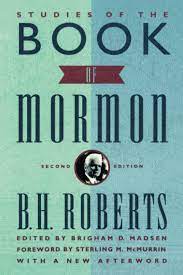
B H Roberts Signature Books 2nd Editions 1992
The story of the Books emergence is fascinating. In the 1920s B H Roberts a prominent member of the quorum of seventy was considered as one of the church’s foremost historians and theologian. His family encouraged the publication of three significant documents, ‘Book of Mormon Difficulties’, ‘Book of Mormon Studies’ and ‘Parallels’ (between the Book of Mormon and Ethan Smiths View of the Hebrews). The church argued that as the contents of these papers were presented to them, they should be considered their rightful owner and contested the right of the papers to be published. The church wanted control of the papers, was it their intention to bury them like a number of the embarrassing Hoffman papers they had begun acquiring? 1st edition published 1985 by University of Utah Research Foundation.
On 22 August 1921, a church member William E Riter writes to apostle James E Talmage of discussions with Non Mormons, particularly a Mr Couch of Washington, enclosing five questions. Talmage passes the letter to B H Roberts who endeavours to find answers. The route of enquiry pursued by Roberts eventually leads to a two day conference in early January 1922 between Roberts, the first presidency, quorum of the twelve apostles and a few other invited members to hear Roberts outline difficulties associated with the Book of Mormon. Instead of soliciting insight and assistance towards finding answers Roberts received a volley of testimonies that the Book of Mormon was true. He found the reaction of the brethren disappointing. This unsatisfactory experience fuelled further investigation that he had to undertake as a Mission President in New York state. To which cynics argued, he was hastily called.
As Mission President for five years in New York he became aware of several books that were widespread and prominent in the state area during the early 19th century. Namely Ethan Smith’s ‘View of the Hebrews’ and Josiah Priests works, ‘American Antiquities’ and ‘Wonders of Nature and Providence’. In Roberts estimation these books could have fuelled the imaginative mind of Joseph Smith.
Mr Couch’s five questions.
1.The time period between Lehi’s landing and the nature of modern Indians languages is too short to account for their divergence according to Philologists
2.Historical and palaeontological data shows that the horse was not present during the Book of Mormon time period or for centuries later
3.Nephi is reported to have broken a bow of steel, there is no known historical evidence that the Jews had any such knowledge of making steel
4.The use of the word scimitar does not occur in any literature predating the rise of Mohammedan power
5.Reference is made to the Nephites having silk, but it was not known during the Book of Mormon time period
I will resist the temptation to list as ‘spoilers’ the parallels between View of the Hebrews and the keystone of our religion, they are numerous. I believe Elder Holland (which I will fact check) employed a ‘Straw man argument’ against View of the Hebrews. He says clearly the Book of Mormon is not a copy of it. The logical fallacy here is to create an extreme claim then argue against it. Roberts says it is probable that Joseph Smith would have been in contact with one book at least….to have furnished structural outlines for the Book of Mormon. The strength of Roberts claim is furthered below.
In Josiah Priest’s Wonder of Nature and Providence, 1824 Rochester New York, he states that 40 known sources suggest the American Indians might be descendants of Israelites, these include William Penn 1774, Dr Jarvis 1811 and Reverend Samuel Sewell, fellow of Harvard College. Priest argues that such widespread discussion throughout New England and the Middle states over the years made such a subject common knowledge.
B H Roberts reasons given the existence of such a body of knowledge ‘a person of vivid and imaginative power in contact with it, there is little room for doubt but that it might be possible for Joseph Smith to construct a theory of origin for his Book of Mormon in harmony with these prevailing notions, and more especially since this common knowledge is set forth in almost handbook form in View of the Hebrews from eight to five years before the Book of Mormon was published’ (bottom of p154).
Any member enountering issues that question the the Book of Mormon’s authenticity will feel uncomfortable. Therefore It is not surprising that general authorities reacted similarly to the way most members have in my limited experience. “I know it’s true because….” This erects a barrier to further discussion. Roberts was incredibly brave and possibly naive in presenting unwanted information, nevertheless then and now, the relevance of his discoveries and searching questions are pertinent. The contents of the book are detailed, his line of thought is relatively easy to follow, he managed to continue serving faithfully despite not finding satisfactory answers. In this respect he is a great role model, whether he could have sustained his position in the wake of more recent discoveries is open to debate. However, we do know he would not have run away from DNA evidence and the like but would have analysed it